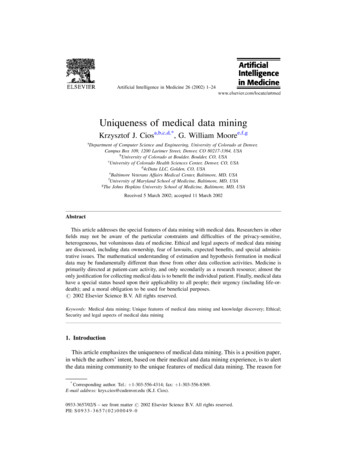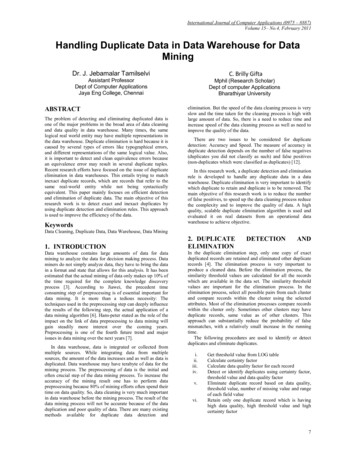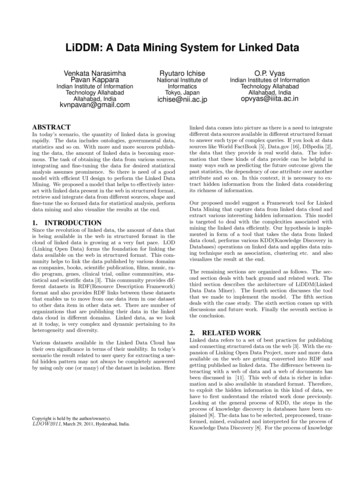
Transcription
FUNDAMENTALS OF DATA MINING INGENOMICS AND PROTEOMICS
FUNDAMENTALS OF DATA MINING INGENOMICS AND PROTEOMICSEdited byWerner DubitzkyUniversity of Ulster, Coleraine, Northern IrelandMartin GranzowQuantiom Bioinformatics GrmbH & Co. KG, Weingarten/Baden, GermanyDaniel BerrarUniversity of Ulster, Coleraine, Northern IrelandSpringer
Library of Congress Control Number: 2006934109ISBN-13: 978-0-387-47508-0ISBN-10: 0-387-47508-7e-ISBN-13: 978-0-387-47509-7e-ISBN-10: 0-387-47509-5Printed on acid-free paper. 2007 Springer Science Business Media, LLCAll rights reserved. This work may not be translated or copied in whole or in part without thewritten permission of the publisher (Springer Science Business Media, LLC, 233 Spring Street,New York, NY 10013, USA), except for brief excerpts in coimection with reviews or scholarlyanalysis. Use in cotmection with any form of information storage and retrieval, electronicadaptation, computer software, or by similar or dissimilar methodology now known or hereafterdeveloped is forbidden.The use in this publication of trade names, trademarks, service marks and similar terms, even ifthey are not identified as such, is not to be taken as an expression of opinion as to whether or notthey are subject to proprietary rights.9 8 7 6 5 4 3 2 1springer.com
PrefaceAs natural phenomena are being probed and mapped in ever-greater detail,scientists in genomics and proteomics are facing an exponentially growing volume of increasingly complex-structured data, information, and knowledge. Examples include data from microarray gene expression experiments, bead-basedand microfluidic technologies, and advanced high-throughput mass spectrometry. A fundamental challenge for life scientists is to explore, analyze, andinterpret this information effectively and efficiently. To address this challenge,traditional statistical methods are being complemented by methods from datamining, machine learning and artificial intelligence, visualization techniques,and emerging technologies such as Web services and grid computing.There exists a broad consensus that sophisticated methods and tools fromstatistics and data mining are required to address the growing data analysisand interpretation needs in the life sciences. However, there is also a great dealof confusion about the arsenal of available techniques and how these shouldbe used to solve concrete analysis problems. Partly this confusion is due toa lack of mutual understanding caused by the different concepts, languages,methodologies, and practices prevailing within the different disciplines.A typical scenario from pharmaceutical research should illustrate some ofthe issues. A molecular biologist conducts nearly one hundred experimentsexamining the toxic effect of certain compounds on cultured cells using amicroarray gene expression platform. The experiments include different compounds and doses and involves nearly 20 000 genes. After the experiments arecompleted, the biologist presents the data to the bioinformatics departmentand briefly explains what kind of questions the data is supposed to answer.Two days later the biologist receives the results which describe the output ofa cluster analysis separating the genes into groups of activity and dose. Whilethe groups seem to show interesting relationships, they do not directly addressthe questions the biologist has in mind. Also, the data sheet accompanyingthe results shows the original data but in a different order and somehow transformed. Discussing this with the bioinformatician again it turns out that what
viPrefacethe biologist wanted was not clustering {automatic classification or automaticclass prediction) but supervised classification or supervised class prediction.One main reason for this confusion and lack of mutual understanding isthe absence of a conceptual platform that is common to and shared by the twobroad disciplines, life science and data analysis. Another reason is that datamining in the life sciences is different to that in other typical data miningapplications (such as finance, retail, and marketing) because many requirements are fundamentally different. Some of the more prominent differencesare highlighted below.A common theme in many genomic and proteomic investigations is theneed for a detailed understanding (descriptive, predictive, explanatory) ofgenome- and proteome-related entities, processes, systems, and mechanisms.A vast body of knowledge describing these entities has been accumulated ona staggering range of life phenomena. Most conventional data mining applications do not have the requirement of such a deep understanding and thereis nothing that compares to the global knowledge base in the hfe sciences.A great deal of the data generated in genomics and proteomics is generatedin order to analyze and interpret them in the context of the questions and hypotheses to be answered and tested. In many classical data mining scenarios,the data to be analyzed axe generated as a "by-product" of an underlying business process (e.g., customer relationship management, financial transactions,process control, Web access log, etc.). Hence, in the conventional scenariothere is no notion of question or hypothesis at the point of data generation.Depending on what phenomenon is being studied and the methodologyand technology used to generate data, genomic and proteomic data structures and volumes vary considerably. They include temporally and spatiallyresolved data (e.g., from various imaging instruments), data from spectralanalysis, encodings for the sequential and spatial representation of biological macromolecules and smaller chemical and biochemical compounds, graphstructures, and natural language text, etc. In comparison, data structuresencountered in typical data mining applications are simple.Because of ethical constraints and the costs and time involved to run experiments, most studies in genomics and proteomics create a modest number ofobservation points ranging from several dozen to several hundreds. The number of observation points in classical data mining applications ranges fromthousands to millions. On the other hand, modern high-throughput experiments measure several thousand variables per observation, much more thanencountered in conventional data mining scenarios.By definition, research and development in genomics and proteomics issubject to constant change - new questions are being asked, new phenomenaare being probed, and new instruments are being developed. This leads to frequently changing data processing pipelines and workflows. Business processesin classical data mining areas are much more stable. Because solutions willbe in use for a long time, the development of complex, comprehensive, and
Prefaceviiexpensive data mining applications (such as data warehouses) is readily justified.Genomics and proteomics are intrinsically "global" - in the sense that hundreds if not thousands of databases, knowledge bases, computer programs, anddocument libraries are available via the Internet and are used by researchersand developers throughout the world as part of their day-to-day work. The information accessible through these sources form an intrinsic part of the dataanalysis and interpretation process. No comparable infrastructure exists inconventional data mining scenarios.This volume presents state of the art analytical methods to address keyanalysis tasks that data from genomics and proteomics involve. Most importantly, the book will put particular emphasis on the common caveats andpitfalls of the methods by addressing the following questions: What are therequirements for a particular method? How are the methods deployed andused? When should a method not be used? What can go wrong? How can theresults be interpreted? The main objectives of the book include: To be acceptable and accessible to researchers and developers both in lifescience and computer science disciplines - it is therefore necessary to express the methodology in a language that practitioners in both disciplinesunderstand;To incorporate fundamental concepts from both conventional statisticsas well as the more exploratory, algorithmic and computational methodsprovided by data mining;To take into account the fact that data analysis in genomics and proteomicsis carried out against the backdrop of a huge body of existing formalknowledge about life phenomena and biological systems;To consider recent developments in genomics and proteomics such as theneed to view biological entities and processes as systems rather than collections of isolated parts;To address the current trend in genomics and proteomics towards increasing computerization, for example, computer-based modeling and simulartion of biological systems and the data analysis issues arising from largescale simulations;To demonstrate where and how the respective methods have been successfully employed and to provide guidelines on how to deploy and usethem;To discuss the advantages and disadvantages of the presented methods,thus allowing the user to make an informed decision in identifying andchoosing the appropriate method and tool;To demonstrate potential caveats and pitfalls of the methods so as toprevent any inappropriate use;To provide a section describing the formal aspects of the discussed methodologies and methods;
viii PrefaceTo provide an exhaustive list of references the reader can follow up toobtain detailed information on the approaches presented in the book;To provide a list of freely and commercially available software tools.It is hoped that this volume will (i) foster the understanding and use ofpowerful statistical and data mining methods and tools in life science as wellas computer science and (ii) promote the standardization of data analysis andinterpretation in genomics and proteomics.The approach taken in this book is conceptual and practical in nature.This means that the presented dataranalytical methodologies and methodsare described in a largely non-mathematical way, emphasizing an informationprocessing perspective (input, output, parameters, processing, interpretation)and conceptual descriptions in terms of mechanisms, components, and properties. In doing so, the reader is not required to possess detailed knowledgeof advanced theory and mathematics. Importantly, the merits and limitationsof the presented methodologies and methods are discussed in the context of"real-world" data from genomics and proteomics. Alternative techniques arementioned where appropriate. Detailed guidelines are provided to help practitioners avoid common caveats and pitfalls, e.g., with respect to specific parameter settings, sampling strategies for classification tasks, and interpretationof results. For completeness reasons, a short section outlining mathematicaldetails accompanies a chapter if appropriate. Each chapter provides a richreference list to more exhaustive technical and mathematical literature aboutthe respective methods.Our goal in developing this book is to address complex issues arising fromdata analysis and interpretation tasks in genomics and proteomics by providing what is simultaneously a design blueprint, user guide, and research agendafor current and future developments in the field.As design blueprint, the book is intended for the practicing professional(researcher, developer) tasked with the analysis and interpretation of datagenerated by high-throughput technologies in genomics and proteomics, e.g.,in pharmaceutical and biotech companies, and academic institutes.As a user guide, the book seeks to address the requirements of scientistsand researchers to gain a basic understanding of existing concepts and methods for analyzing and interpreting high-throughput genomics and proteomicsdata. To assist such users, the key concepts and assumptions of the varioustechniques, their conceptual and computational merits and limitations are explained, and guidelines for choosing the methods and tools most appropriateto the analytical tasks are given. Instead of presenting a complete and intricate mathematical treatment of the presented analysis methodologies, ouraim is to provide the users with a clear understanding and practical know-howof the relevant concepts and methods so that they are able to make informedand effective choices for data preparation, parameter setting, output postprocessing, and result interpretation and validation.
PrefaceixAs a research agenda, this volume is intended for students, teachers, researchers, and research managers who want to understand the state of theart of the presented methods and the areas in which gaps in our knowledgedemand further research and development. To this end, our aim is to maintainthe readability and accessibility throughout the chapters, rather than compiling a mere reference manual. Therefore, considerable effort is made to ensurethat the presented material is supplemented by rich literature cross-referencesto more foundational work.In a quarter-length course, one lecture can be devoted to two chapters,and a project may be assigned based on one of the topics or techniques discussed in a chapter. In a semester-length course, some topics can be covered ingreater depth, covering - perhaps with the aid of an in-depth statistics/datamining text - more of the formal background of the discussed methodology.Throughout the book concrete suggestions for further reading are provided.Clearly, we cannot expect to do justice to all three goals in a single book.However, we do beheve that this book has the potential to go a long wayin bridging a considerable gap that currently exists between scientists in thefield of genomics and proteomics on one the hand and computer scientistson the other hand. Thus, we hope, this volume will contribute to increasedcommunication and collaboration across the disciplines and will help facilitatea consistent approach to analysis and interpretation problems in genomics andproteomics in the future.This volume comprises 12 chapters, which follow a similar structure interms of the main sections. The centerpiece of each chapter represents a casestudy that demonstrates the use - and misuse - of the presented method orapproach. The first chapter provides a general introduction to the field of datamining in genomics and proteomics. The remaining chapters are intended toshed more light on specific methods or approaches.The second chapter focuses on study design principles and discusses replication, blocking, and randomization. While these principles are presented inthe context of microarray experiments, they are applicable to many types ofexperiments.Chapter 3 addresses data pre-processing in cDNA and oligonucleotide microarrays. The methods discussed include background intensity correction,data normalization and transformation, how to make gene expression levelscomparable across different arrays, and others.Chapter 4 is also concerned with pre-processing. However, the focus isplaced on high-throughput mass spectrometry data. Key topics include baseline correction, intensity normalization, signal denoising (e.g., via wavelets),peak extraction, and spectra alignment.Data visualization plays an important role in exploratory data analysis.Generally, it is a good idea to look at the distribution of the data priorto analysis. Chapter 5 revolves around visualization techniques for highdimensional data sets, and puts emphasis on multi-dimensional scaling. Thistechnique is illustrated on mass spectrometry data.
XPrefaceChapter 6 presents the state of the art of clustering techniques for discovering groups in high-dimensional data. The methods covered include hierarchicaland fc-means clustering, self-organizing maps, self-organizing tree algorithms,model-based clustering, and cluster validation strategies, such as functionalinterpretation of clustering results in the context of microarray data.Chapter 7 addresses the important topics of feature selection, featureweighting, and dimension reduction for high-dimensional data sets in genomicsand proteomics. This chapter also includes statistical tests (parametric or nonparametric) for assessing the significance of selected features, for example,based on random permutation testing.Since data sets in genomics and proteomics are usually relatively smallwith respect to the number of samples, predictive models are frequently testedbased on resampled data subsets. Chapter 8 reviews some common dataresampling strategies, including n-fold cross-validation, leave-one-out crossvalidation, and repeated hold-out method.Chapter 9 discusses support vector machines for classification tasks, andillustrates their use in the context of mass spectrometry data.Chapter 10 presents graphs and networks in genomics and proteomics, suchas biological networks, pathways, topologies, interaction patterns, gene-geneinteractome, and others.Chapter 11 concentrates on time series analysis in genomics. A methodology for identifying important predictors of time-varying outcomes is presented.The methodology is illustrated in a study aimed at finding mutations of thehuman immunodeficiency virus that are important predictors of how well apatient responds to a drug regimen containing two different antiretroviraldrugs.Automated extraction of information from biological literature promisesto play an increasingly important role in text-based knowledge discoveryprocesses. This is particularly important for high-throughput approaches suchas microarrays and high-throughput proteomics. Chapter 12 addresses knowledge extraction via text mining and natural language processing.Finally, we would like to acknowledge the excellent contributions of theauthors and Alice McQuillan for her help in proofreading.Coleraine, Northern Ireland, and Weingajten, GermanyWerner DubitzkyMartin GranzowDaniel Berrar
PrefacexiThe following list shows the symbols or abbreviations for the most commonly occurring quantities/terms in the book. In general, uppercase boldfacedletters such as X refer to matrices. Vectors are denoted by lowercase boldfacedletters, e.g., x, while scalars are denoted by lowercase italic letters, e.g., x.List of Abbreviations and SHMMMSm/zNLPNPVPCAPCRAverage (test) classification errorAnalysis of varianceAutomatic relevance determinationArea under the curve (in ROC analysis)Balanced accuracy (average of sensitivity and specificity)Balanced accuracyBase pairClassification and regression treeCross-validationDaltonsDecimated discrete wavelet transformElectrospray ionizationExpressed sequence tagExperimental treatment assignmentFalse discovery rateFisher's linear discriminantFalse negativeFalse positiveFalse positive rateFamily-wise error rateGene Expression OmnibusGene OntologyIndependent component analysisInformation extractionInterquartile rangeInformation retrievalLeave-one-out cross-validationMatrix-assisted laser desorption/ionizationMultidimensional scalingMedical Subject HeadingsMismatchMass spectrometryMass-over-chargeNatural language processingNegative predictive valuePrincipal component analysispolymerase chain reaction
SHSVDSVMTICTNTOPTPUDWTVSN#( )Xee.632ViETx'Dd{x,y)E{X)(k)LiTiTRijVi,Polymerase chain reactionPartial least squaresPerfect matchPositive predictive valueRelative log expressionRegularized logistic regressionRobust multi-chip analysisSignal-to-noiseSerial analysis of gene expressionSignificance analysis of gene expressionSurface-enhance laser desorption/ionizationSelf-organizing mapSelf-organizing tree algorithmSuppression substractive hybridizationSingular value decompositionSupport vector machineTotal ion currentTrue negativeTime-of-flightTrue positiveUndecimated discrete wavelet transformVariance stabilization normalizationCounts; the number of instances satisfying the condition in ( )The mean of all elements in xChi-square statisticObserved error rateEstimate for the classification error in the .632 bootstrapPredicted value for yi (i.e., predicted class label for case Xj)Not yCovarianceTrue error rateTranspose of vector xData setDistance between x and yExpectation of a random variable XAverage of ki* learning setSet of real numbersi*'* test setTraining set of the i*'* external and j * ' * internal loopValidation set of the i* external and j internal loopjth ygj- gx in a network
Contents1 Introduction to Genomic and Proteomic Data AnalysisDaniel Berrar, Martin Granzow, and Werner Dubitzky1.1 Introduction1.2 A Short Overview of Wet Lab Techniques1.2.1 Transcriptomics Techniques in a Nutshell1.2.2 Proteomics Techniques in a Nutshell1.3 A Few Words on Terminology1.4 Study Design1.5 Data Mining1.5.1 Mapping Scientific Questions to Analytical Tasks1.5.2 Visual Inspection1.5.3 Data Pre-Processing1.5.3.1 Handling of Missing Values1.5.3.2 Data Transformations1.5.4 The Problem of Dimensionality1.5.4.1 Mapping to Lower Dimensions1.5.4.2 Feature Selection and Significance Analysis1.5.4.3 Test Statistics for Discriminatory Features1.5.4.4 Multiple Hypotheses Testing1.5.4.5 Random Permutation Tests1.5.5 Predictive Model Construction1.5.5.1 Basic Measures of Performance1.5.5.2 Training, Validating, and Testing1.5.5.3 Data Resampling Strategies1.5.6 Statistical Significance Tests for Comparing Models1.6 Result Post-Processing1.6.1 Statistical Validation1.6.2 Epistemological Validation1.6.3 Biological Validation1.7 2224252729313132323233
xivContents2 Design Principles for Microarray InvestigationsKathleen F. Kerr2.1 Introduction2.2 The "Pre-Planning" Stage2.2.1 Goal 1: Unsupervised Learning2.2.2 Goal 2: Supervised Learning2.2.3 Goal 3: Class Comparison2.3 Statistical Design Principles, Applied to Microarrays2.3.1 Replication2.3.2 Blocking2.3.3 Randomization2.4 Case Study2.5 ConclusionsReferences393939404141424243464747483 Pre-Processing D N A Microarray DataBenjamin M. Bolstad3.1 Introduction3.1.1 Affymetrix GeneChips3.1.2 Two-Color Microarrays3.2 Basic Concepts3.2.1 Pre-Processing Affymetrix GeneChip Data3.2.2 Pre-Processing Two-Color Microarray Data3.3 Advantages and Disadvantages3.3.1 Affymetrix GeneChip Data3.3.1.1 Advantages3.3.1.2 Disadvantages3.3.2 Two-Color Microarrays3.3.2.1 Advantages3.3.2.2 Disadvantages3.4 Caveats and Pitfalls3.5 Alternatives3.5.1 Affymetrix GeneChip Data3.5.2 Two-Color Microarrays3.6 Case Study3.6.1 Pre-Processing an Affymetrix GeneChip Data Set3.6.2 Pre-Processing a Two-Channel Microarray Data Set3.7 Lessons Learned3.8 List of Tools and Resources3.9 Conclusions3.10 Mathematical Details3.10.1 RMA Background Correction Equation3.10.2 Quantile Normalization3.10.3 RMA Model3.10.4 Quality Assessment 697374747474757575
Contents3.10.5 Computation of M and A Values for Two-ChannelMicroarray Data3.10.6 Print-Tip Loess NormalizationReferences4 Pre-Processing Mass Spectrometry DataKevin R. Coombes, Keith A. Baggerly, and Jeffrey S. Morris4.1 Introduction4.2 Basic Concepts4.3 Advantages and Disadvantages4.4 Caveats and Pitfalls4.5 Alternatives4.6 Case Study: Experimental and Simulated Data Sets for ComparingPre-Processing Methods4.7 Lessons Learned4.8 List of Tools and Resources4.9 95 Visualization in Genomics and ProteomicsXiaochun Li and Jaroslaw Harezlak5.1 Introduction5.2 Basic Concepts5.2.1 Metric Scaling5.2.2 Nonmetric Scaling5.3 Advantages and Disadvantages5.4 Caveats and Pitfalls5.5 Alternatives5.6 Case Study: MDS on Mass Spectrometry Data5.7 Lessons Learned5.8 List of Tools and Resources5.9 81191201216 Clustering - Class Discovery in the Post-Genomic EraJoaquin Dopazo6.1 Introduction6.2 Basic Concepts6.2.1 Distance Metrics6.2.2 Clustering Methods6.2.2.1 Aggregative Hierarchical Clustering6.2.2.2 A;-Means6.2.2.3 Self-Organizing Maps6.2.2.4 Self-Organizing Tree Algorithm6.2.2.5 Model-Based Clustering6.2.3 Biclustering123123126126127128129130130130131
xviContents6.2.4 Validation Methods6.2.5 Functional Annotation6.3 Advantages and Disadvantages6.4 Caveats and Pitfalls6.4.1 On Distances6.4.2 On Clustering Methods6.5 Alternatives6.6 Case Study6.7 Lessons Learned6.8 List of Tools and Resources6.8.1 General Resources6.8.1.1 Multiple Purpose Tools (Including Clustering)6.8.2 Clustering Tools6.8.3 Biclustering Tools6.8.4 Time Series6.8.5 Public-Domain Statistical Packages and Other Tools6.8.6 Functional Analysis Tools6.9 01401401411411411411421421437 Feature Selection cind Dimensionality Reduction inGenomics and ProteomicsMilos Hauskrecht, Richard Pelikan, Michal Valko, and JamesLyons- Weiler1497.1 Introduction1497.2 Basic Concepts1517.2.1 Filter Methods1517.2.1.1 Criteria Based on Hypothesis Testing1517.2.1.2 Permutation Tests1527.2.1.3 Choosing Features Based on the Score1537.2.1.4 Feature Set Selection and ControUing False Positives . 1537.2.1.5 Correlation Filtering1547.2.2 Wrapper Methods1557.2.3 Embedded Methods1557.2.3.1 Regularization/Shrinkage Methods1557.2.3.2 Support Vector Machines1567.2.4 Feature Construction1567.2.4.1 Clustering1567.2.4.2 Clustering Algorithms1587.2.4.3 Probabilistic (Soft) Clustering1587.2.4.4 Clustering Features1587.2.4.5 Principal Component Analysis1597.2.4.6 Discriminative Projections1597.3 Advantages and Disadvantages1607.4 Case Study: Pancreatic Cancer161
Contents7.4.1 Data and Pre-Processing7.4.2 Filter Methods7.4.2.1 Basic Filter Methods7.4.2.2 Controlling False Positive Selections7.4.2.3 Correlation Filters7.4.3 Wrapper Methods7.4.4 Embedded Methods7.4.5 Feature Construction Methods7.4.6 Summary of Analysis Results and Recommendations7.5 Conclusions7.6 Mathematical DetailsReferences8 Resampling Strategies for Model Assessment and SelectionRichard Simon8.1 Introduction8.2 Basic Concepts8.2.1 Resubstitution Estimate of Prediction Error8.2.2 Split-Sample Estimate of Prediction Error8.3 Resampling Methods8.3.1 Leave-One-Out Cross-Validation8.3.2 fc-fold Cross-Validation8.3.3 Monte Carlo Cross-Validation8.3.4 Bootstrap Resampling8.3.4.1 The .632 Bootstrap8.3.4.2 The .632-F Bootstrap8.4 Resampling for Model Selection and Optimizing Tuning Parameters8.4.1 Estimating Statistical Significance of Classification Error Rates8.4.2 Comparison to Classifiers Based on Standard PrognosticVariables8.5 Comparison of Resampling Strategies8.6 Tools and Resources8.7 ConclusionsReferences9 Classification of Genomic and Proteomic Data UsingSupport Vector MachinesPeter Johansson and Markus Ringner9.1 Introduction9.2 Basic Concepts9.2.1 Support Vector Machines9.2.2 Feature Selection9.2.3 Evaluating Predictive Performance9.3 Advantages and Disadvantages9.3.1 4185186187187187188190191192192
xviiiContents9.3.2 Disadvantages9.4 Caveats and Pitfalls9.5 Alternatives9.6 Case Study: Classification of Mass Spectral Serum Profiles UsingSupport Vector Machines9.6.1 Data Set9.6.2 Analysis Strategies9.6.2.1 Strategy A: SVM without Feature Selection9.6.2.2 Strategy B: SVM with Feature Selection9.6.2.3 Strategy C: SVM Optimized Using Test SamplesPerformance9.6.2.4 Strategy D: SVM with Feature Selection Using TestSamples9.6.3 Results9.7 Lessons Learned9.8 List of Tools and Resources9.9 Conclusions9.10 Mathematical DetailsReferences10 Networks in Cell BiologyCarlos Rodriguez-Caso and Ricard V. Sole10.1 Introduction10.1.1 Protein Networks10.1.2 Metabolic Networks10.1.3 Transcriptional Regulation Maps10.1.4 Signal Transduction Pathways10.2 Basic Concepts10.2.1 Graph Definition10.2.2 Node Attributes10.2.3 Graph Attributes10.3 Caveats and Pitfalls10.4 Case Study: Topological Analysis of the Human TranscriptionFactor Interaction Network10.5 Lessons Learned10.6 List of Tools and Resources10.7 Conclusions10.8 Mathematical DetailsReferences11 Identifying Important Explanatory Variables forTime-Varying OutcomesOliver Bembom, Maya L. Petersen, and Mark J. van der Laan11.1 Introduction11.2 Basic 0220221227227229
Contents11.3 Advantages and Disadvantages11.3.1 Advantages11.3.2 Disadvantages11.4 Caveats and Pitfalls11.5 Alternatives11.6 Case Study: HIV Drug Resistance Mutations11.7 Lessons Learned11.8 List of Tools and Resources11.9 ConclusionsReferences12 Text Mining in Genomics and ProteomicsRobert Hoffmann12.1 Introduction12.1.1 Text Mining12.1.2 Interactive Literature Exploration12.2 Basic Concepts12.2.1 Information Retrieval12.2.2 Entity Recognition12.2.3 Information Extraction12.2.4 Biomedical Text Resources12.2.5 Assessment and Comparison of Text Mining Methods12.3 Caveats and Pitfalls12.3.1 Entity Recognition12.3.2 Full Text12.3.3 Distribution of Information12.3.4 The Impossible12.3.5 Overall Performance12.4 Alternatives12.4.1 Functional Coherence Analysis of Gene Groups12.4.2 Co-Occurrence Networks12.4.3 Superimposition of Experimental Data to the LiteratureNetwork12.4.4 Gene Ontologies12.5 Case Study12.6 Lessons Learned12.7 List of Tools and Resources12.8 Conclusion12.9 Mathematical 258259259260260261261265266266270270275
List of ContributorsK e i t h A. BaggerlyDepartment of Biostatistics andApplied Mathematics, University ofTexas M.D. Anderson CancerCenter, Houston, TX 77030, USA.kabagg@wotan.mdacc.tmc.eduOliver BetnbotnDivision of Biostatistics, Universityof California, Berkeley, CA 947207360, USA.bembom@berkeley.eduDaniel B e r r a rSystems Biology Research Group,University of Ulster, NorthernIreland, UK.dp.berrarQulster.ac.ukBenjamin M . BolstadDepartment of Statistics, Universityof California, Berkeley, CA 947
A great deal of the data generated in genomics and proteomics is generated in order to analyze and interpret them in the context of the questions and hy potheses to be answered and tested. In many classical data mining scenarios, the data to be analyzed axe generated as a "by-product" of an underlying busi











